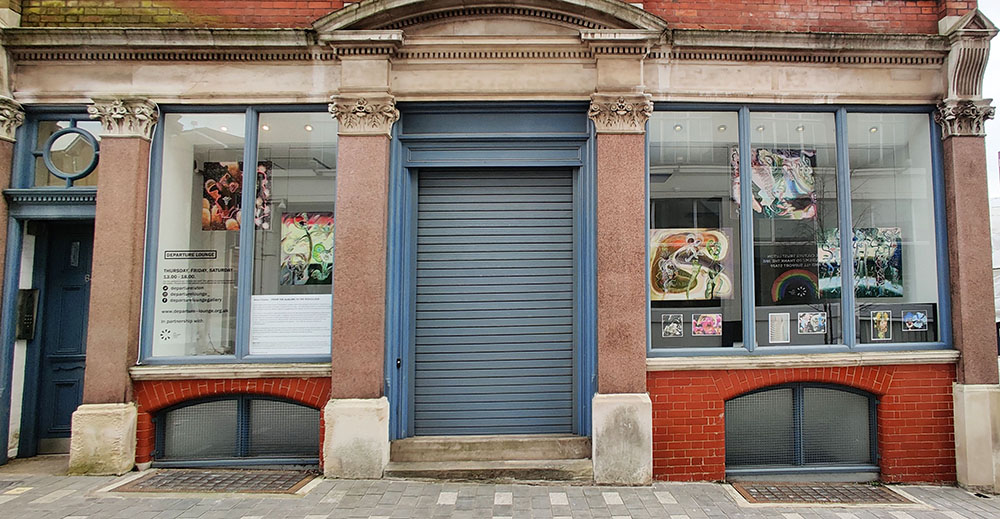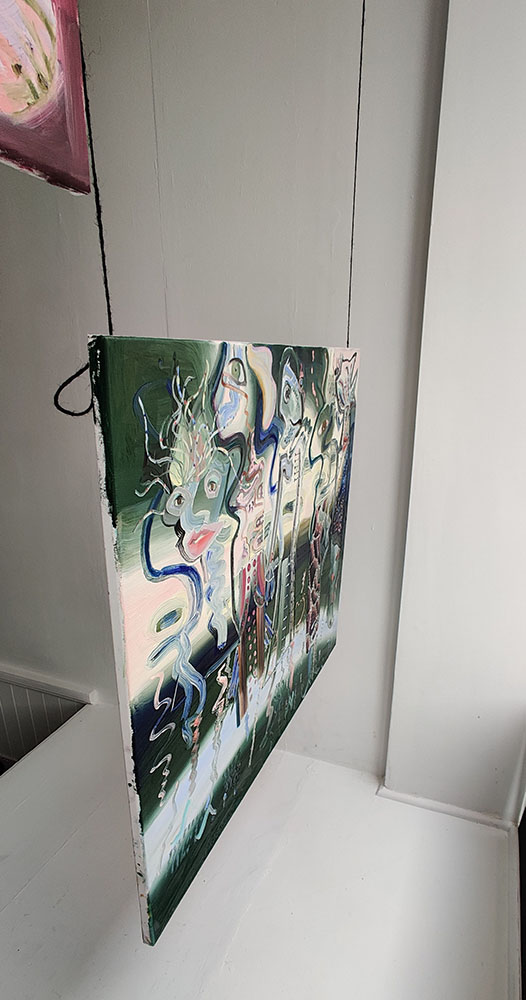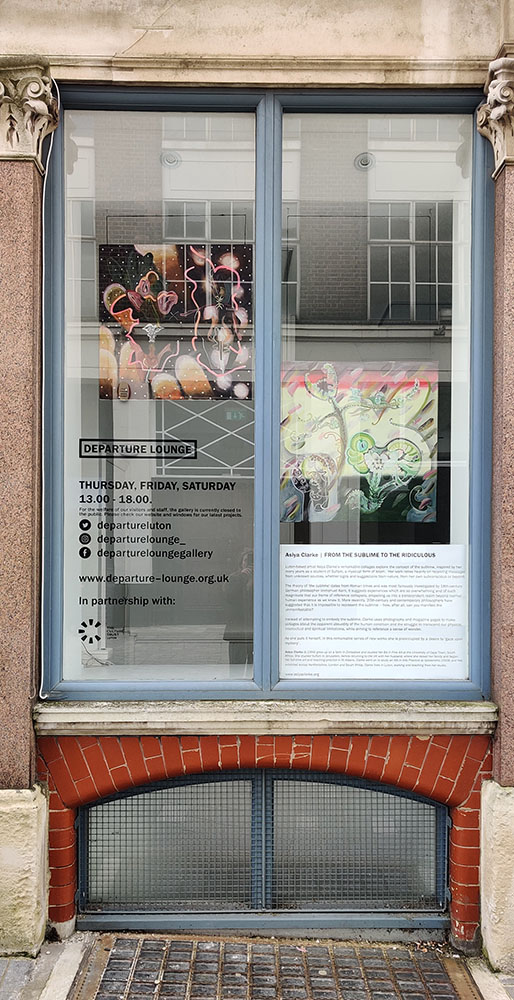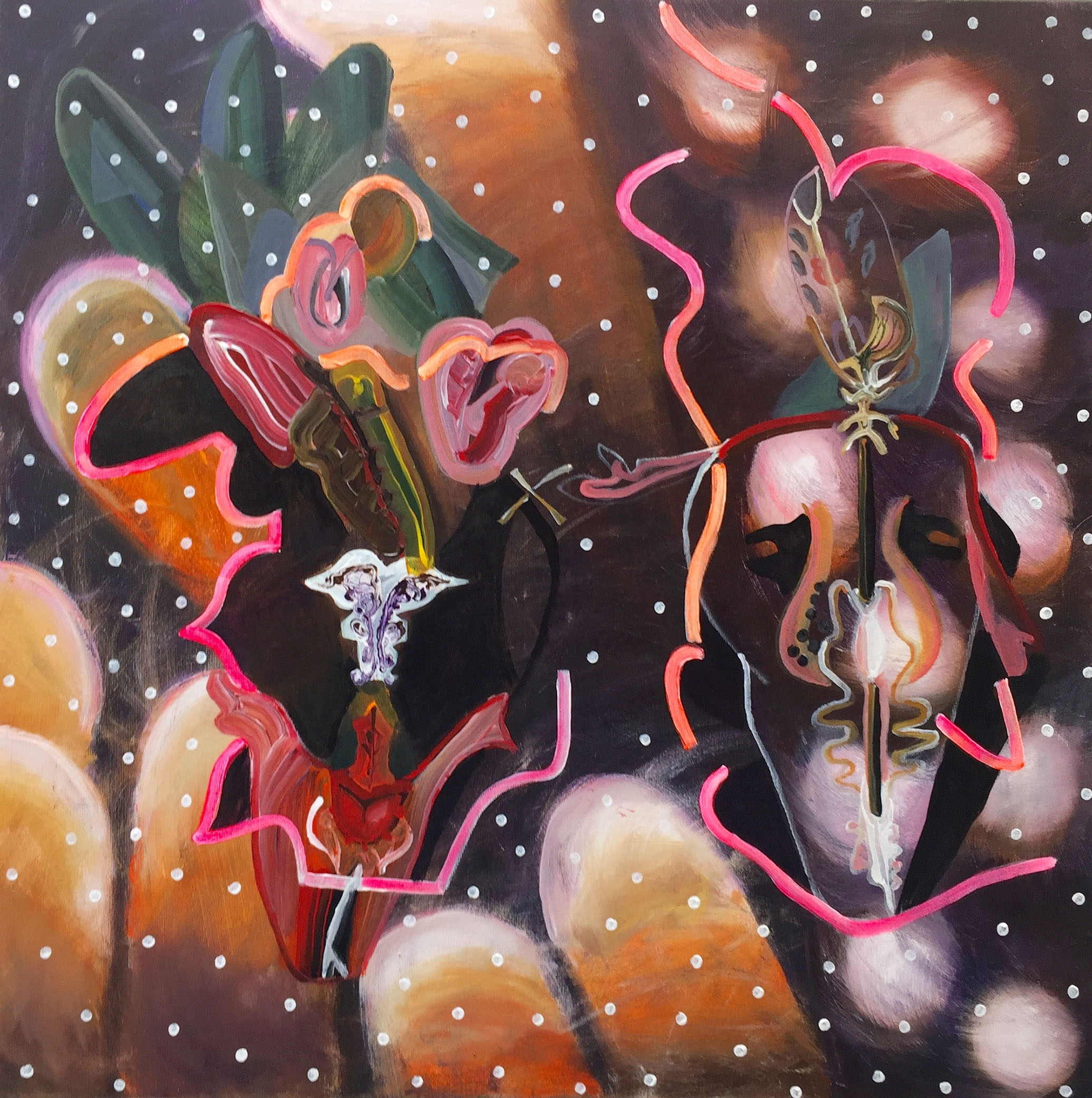Asiya Clarke - FROM THE SUBLIME TO THE RIDICULOUS
15 February - 10 March 2021
(Window + online exhibition only. The gallery remains closed until further notice)Luton-based artist Asiya Clarke’s returns to Departure Lounge, with her remarkable collages exploring the concept of the sublime, inspired by her many years as a student of Sufism, a mystical form of Islam. Her work relies heavily on receiving messages from unknown sources, whether signs and suggestions from nature, from her own subconscious or beyond.










The theory of ‘the sublime’ dates from Roman times and was most famously investigated by
18th-century German philosopher Immanuel Kant. It suggests experiences which are so overwhelming and of such magnitude that our frame of reference collapses, propelling us into a transcendent realm beyond normal human experience as we know it. More recently, 20th-century and contemporary philosophers have suggested that it is impossible to represent the sublime – how, after all, can you manifest the unmanifestable?
Instead of attempting to embody the sublime, Clarke uses photographs and magazine pages to make collages about the apparent absurdity of the human condition and the struggle to transcend our physical, intellectual and spiritual limitations, while aiming to reference a sense of wonder.
As she puts it herself, in this remarkable series of new works she is preoccupied by a desire to ‘gaze upon mystery’.










In-conversation with artist Asiya Clarke and curator Sammy Maitland

SM: Can you give us a brief overview of your practice, specifically the work you’ve been creating recently?
AC: Collage has always been central to my practice, but particularly recently. I had a stroke, a brain haemorage, completely out of the blue, in August of 2018 and this had a huge impact on my work and my life generally. It really was a wake up call, reminding me how fragile life is, how limited our time is and how much there is to be grateful for. Fortunately I have made a good recovery, thanks enormously to the help and support I received and my work has been a great comfort, a welcome escape and a wonderful therapy. I began collaging photographs I'd taken shortly after this. It seemed a more direct way to work and it made a shift in my approach, moving me more towards figuration. My work has always been about nature, with the human condition as an inevitable part of nature. Since I made the "Die before you die" pieces for my Goldsmiths degree show in 2008, I've been interested in the transformation that takes place in the mind as one perceives one thing and interprets it as another - what one of my tutors called "the elegant flip-flop from material to embodiment." In this moment of transition one somehow experiences in a new way, with a clarity, the mind of the viewer filling in the gaps and making it participatory. One only needs to add an eye to bring about life, awareness, character, a story. Most of my paintings are developed from collages - painting offers greater flexibility, scope and scale.
SM: Your work is largely influenced by Sufism – can you tell us more about Sufism and how it informs your practice?
AC: Sufism is the inner or esoteric aspect of Islam. It involves losing the ego self to realise the divine aspect within, our common shared unity with each other and all things. This can be achieved through the guidance, love and the inspiring example of one who has made the journey of purification him/herself. I was very fortunate to meet such a person in Jerusalem in 1978. The saying of the prophet Mohammed, "die before you die" is referring to the death of the ego, the death of our sense of separateness from the whole, so that we can know our real self before physical death.
I do not see my work as separate from my spiritual life. My aim is to take my ego self out of the work, to be a channel as far as possible. I see myself in constant pursuit of the unknown, and finding meaning and excitement in this. I also see the ego claiming the work and being attached to it as a challenge to be overcome. For me, it's all about letting go and trusting at every stage of the art process.
SM: You often talk about how your work relies on receiving signs and suggestions from nature or messages from your own subconscious and other unknown sources. How do you go about putting these messages together into your paintings, collages or sculptures? Do you have a specific way of working or do you just start creating and see what comes of it?
AC: A combination of the two. I'm always trying different things, seeing if I can push the image further, discover new territory. Chance plays a very important part. I love it when I've laboured away getting all the little scraps in their "right"places and then I bump it accidentally and it's just so much better! I do connect with surrealist methods of Rorschach blots, decalcomania and automatic drawing. I'm always on the look out for that image one spots out of the corner of ones eye; the overlooked, the unexpected. I've worked a lot with photos of reflections - the double image shifted vertically makes a symmetry which immediately becomes rich with associations. I pay attention and trust that inner voice which responds to my last mark by telling me what to do next, the voice Kandinsky called "inner necessity'.
SM: You have a beautiful studio in Luton where you create work and also teach. Can you tell us more about the teaching side of your practice?
AC: I taught for many years, first at high school in South Africa, and then adults in England. I met my husband in Jerusalem and came to England in 1978. After spending ten years raising our three children, I taught recreational classes for adults, starting at Barnfield College in Luton where I taught a class called "Art for fun". This was based on the idea that you don't have to be able to draw to make art. Even back then I was interested in alternative ways of image making, more constructing than drawing. After a while in adult education, I began running my own classes from various church and school halls, my dining room table and finally my studio in Luton. I always had aspirations to teach at university level. My MA at Goldsmiths in 2008 was really stimulating, but when I look back I feel I learnt so much from my students and it was a fertile context for me, which of course fed into my practice. I haven't taught since having the stroke, I'm concentrating on my own work now.
SM: Do you have anything coming up or plans for your practice that you’d like to share?
AC: Just to keep going and see where it takes me! We are about to move to the Gower peninsular in Wales, to be nearer to family and the sea. I hope I will make contacts there. I'm so grateful to Matthew Shaul of Departure Lounge, who has supported me so brilliantly since I won the St Albans Open in 2003.
Asiya Clarke (b.1954) grew up on a farm in Zimbabwe and studied her BA in Fine Art at the University of Cape Town, South Africa. She studied Sufism in Jerusalem, before returning to the UK with her husband, where she raised her family and began her full-time art and teaching practice in St Albans. Clarke went on to study an MA in Arts Practice at Goldsmiths (2008) and has exhibited across Hertfordshire, London and South Africa. Clarke lives in Luton, working and teaching from her studio.
www.asiyaclarke.org
Instagram: @clarkeasiya
